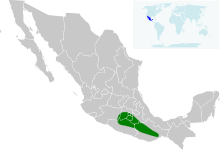Ornate star hummingbird
| Ornate star hummingbird | ||||||||||||
|---|---|---|---|---|---|---|---|---|---|---|---|---|

Ornate Star Hummingbird illustrated by John Gould and Henry Constantine Richter |
||||||||||||
| Systematics | ||||||||||||
|
||||||||||||
| Scientific name | ||||||||||||
| Calothorax pulcher | ||||||||||||
| Gould , 1859 |
The jewelry Star Hummingbird ( Calothorax pulcher ) or jewelry hummingbird is a bird species of the family of hummingbirds (Trochilidae), which is endemic in Mexico is. The IUCN assesses the population as Least Concern . The species is considered to be monotypical .
features
The ornamental star hummingbird reaches a body length of about 8 to 9 cm and a weight of about 2.6 to 3.1 g. It is very similar to the Lucifer star hummingbird and can hardly be distinguished from it in the wild. The male ornamental star hummingbird has a slightly shorter black curved black beak than the Lucifer star hummingbird. The front skull is dull green, the rest of the top is green. The large iridescent collar tab reflects a purple-pink to magenta-colored shimmer, which is slightly elongated at the sides and is delimited by white lines above and below. The rest of the underside is green with small reddish brown spots on the lower flanks. The long forked tail is wider and more rounded at the outermost control feathers than that of the Lucifer star hummingbird. The beak of the female can vary in the degree of curvature, but is generally shorter and straighter than the Lucifer star hummingbird. The top is green. It is yellow-brown on the throat and chest without shimmering feathers. The middle of the belly is white and therefore similar to that of the Lucifer star hummingbird. The tail is doubly rounded, the inner control feathers are green, the outer red-brown, distally black with white spots. Fledglings resemble females in appearance, but males develop some color on their throats in summer.
Behavior and nutrition
The ornamental star hummingbird feeds on the nectar of low-growing coral trees , sage , agaves , cacti and castilleja . It catches smaller insects in flight during short excursions. He starts this from your high seat.
Reproduction
There is a report from a nest in May. The goblet-shaped nest was built on a branch 2.5 meters above the ground. Plant fibers and plant shed were used for the construction, which was decorated on the outside with brown daisy pulp. The clutch consists of two eggs. The incubation period is 15 to 16 days, with the female incubating the eggs. The nestlings fledge after 19 to 22 days.
Vocalizations
The possible singing consists of repeated bright, thin and squeaky tzwi..tzwi..tzwi tones. The sounds contain weak chirping chit tones, some of which are doubled and tripled, and dry shaking tsrrr tones. At Scheuchen he gives off a diminishing twittering. Its hovering flight sounds like bees.
distribution and habitat
The ornamental star hummingbird prefers arid to semi-dry and subtropical scrub, thorny forest and high basins, usually at altitudes of 1000 to 2200 meters. The distribution area extends over the central Guerrero , the southern Puebla , to the southeast and east of Oaxaca . Reports of occurrences in the Federal District , Morelos and Chiapas are in doubt.
migration
The ornamental star hummingbird is a resident bird . Seasonally it occurs from December to April almost at sea level on the isthmus of Tehuantepec .
Etymology and history of research
The jewelry star hummingbird was first described in 1859 by John Gould under the scientific name Calothorax pulchra . The type specimens came from Oaxaca . As early as 1840, George Robert Gray introduced the genus Calothorax a . a. for the Lucifer Star Hummingbird. The term "calothorax" is derived from the Greek words "calos καλος " for "beautiful, beautiful" and "thōrakos θωρακος " for "breastplate". The species name »pulcher, pulchra« is of Latin origin and means »beautiful, attractive, pretty«.
literature
- Peter Evans Scott, Peter Boesman in: Josep del Hoyo , Andrew Elliott, Jordi Sargatal , David Andrew Christie , Eduardo de Juana: Beautiful Hummingbird (Calothorax pulcher) In: Handbook of the Birds of the World Alive . Lynx Edicions, Barcelona.
- James A. Jobling: Helm Dictionary of Scientific Bird Names . Christopher Helm, London 2010, ISBN 978-1-4081-2501-4 .
- John Gould: Descriptions of four new species of humming-birds from Mexico . In: Annals and Magazine of Natural history including Zoology, Botany, and Geology (= 3 ). tape 4 , 1859, p. 96-98 ( biodiversitylibrary.org ).
- George Robert Gray: A list of the genera of birds: with their synonyma an indication of the typical species of each genus / compiled from various source . R. and JE Taylor, London 1840 ( biodiversitylibrary.org ).
Web links
- Calothorax pulcher inthe IUCN Red List of Threatened Species 2018.1. Listed by: BirdLife International, 2016. Retrieved March 12, 2019.
- BirdLife International: Species Factsheet - Beautiful Hummingbird ( Calothorax pulcher ) . Retrieved March 12, 2019.
- Videos, photos and sound recordings for Beautiful Hummingbird (Calothorax pulcher) in the Internet Bird Collection
- Ornamental Star Hummingbird ( Calothorax pulcher ) at Avibase; accessed on March 12, 2019.
- Calothorax pulcher in the Integrated Taxonomic Information System (ITIS). Retrieved on 2019-03-12.
- xeno-canto: Sound recordings - Star hummingbird ( Calothorax pulcher )
- Beautiful hummingbird (Calothorax lucifer) in the Encyclopedia of Life . Retrieved March 12, 2019.
Individual evidence
Remarks
- ↑ He also assigned L'Oiseau-Mouche Barbe-Bleue ( Ornismya cyanopogon Lesson, RP , 1829) to the genus.
